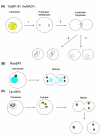HTLV-1 Tax: centrosome amplification and cancer
- PMID: 16899128
- PMCID: PMC1555608
- DOI: 10.1186/1742-4690-3-50
HTLV-1 Tax: centrosome amplification and cancer
Abstract
During interphase, each cell contains a single centrosome that acts as a microtubule organizing center for cellular functions in interphase and in mitosis. Centrosome amplification during the S phase of the cell cycle is a tightly regulated process to ensure that each daughter cell receives the proper complement of the genome. The controls that ensure that centrosomes are duplicated exactly once in the cell cycle are not well understood. In solid tumors and hematological malignancies, centrosome abnormalities resulting in aneuploidy is observed in the majority of cancers. These phenotypes are also observed in cancers induced by viruses, including adult T cell lymphoma which is caused by the human T cell lymphotrophic virus Type 1 (HTLV-1). Several reports have indicated that the HTLV-1 transactivator, Tax, is directly responsible for the centrosomal abnormalities observed in ATL cells. A recent paper in Nature Cell Biology by Ching et al. has shed some new light into how Tax may be inducing centrosome abnormalities. The authors demonstrated that 30% of ATL cells contained more than two centrosomes and expression of Tax alone induced supernumerary centrosomes. A cellular coiled-coil protein, Tax1BP2, was shown to interact with Tax and disruption of this interaction led to failure of Tax to induce centrosome amplification. Additionally, down-regulation of Tax1BP2 led to centrosome amplification. These results suggest that Tax1BP2 may be an important block to centrosome re-duplication that is observed in normal cells. Presently, a specific cellular protein that prevents centrosome re-duplication has not been identified. This paper has provided further insight into how Tax induces centrosome abnormalities that lead to ATL. Lastly, additional work on Tax1BP2 will also provide insight into how the cell suppresses centrosome re-duplication during the cell cycle and the role that Tax1BP2 plays in this important cellular pathway.
Figures

Similar articles
-
The retroviral oncoprotein Tax targets the coiled-coil centrosomal protein TAX1BP2 to induce centrosome overduplication.Nat Cell Biol. 2006 Jul;8(7):717-24. doi: 10.1038/ncb1432. Epub 2006 Jun 11. Nat Cell Biol. 2006. PMID: 16767081
-
Centrosome amplification in adult T-cell leukemia and human T-cell leukemia virus type 1 Tax-induced human T cells.Cancer Sci. 2006 Sep;97(9):836-41. doi: 10.1111/j.1349-7006.2006.00254.x. Epub 2006 Jun 29. Cancer Sci. 2006. PMID: 16805820 Free PMC article.
-
Abnormal centrosome amplification in cells through the targeting of Ran-binding protein-1 by the human T cell leukemia virus type-1 Tax oncoprotein.Proc Natl Acad Sci U S A. 2005 Dec 27;102(52):18974-9. doi: 10.1073/pnas.0506659103. Epub 2005 Dec 19. Proc Natl Acad Sci U S A. 2005. PMID: 16365316 Free PMC article.
-
Centrosome and retroviruses: the dangerous liaisons.Retrovirology. 2007 Apr 14;4:27. doi: 10.1186/1742-4690-4-27. Retrovirology. 2007. PMID: 17433108 Free PMC article. Review.
-
Role of Tax protein in human T-cell leukemia virus type-I leukemogenicity.Retrovirology. 2004 Aug 13;1:20. doi: 10.1186/1742-4690-1-20. Retrovirology. 2004. PMID: 15310405 Free PMC article. Review.
Cited by
-
Viral transformation and aneuploidy.Environ Mol Mutagen. 2009 Oct;50(8):733-40. doi: 10.1002/em.20480. Environ Mol Mutagen. 2009. PMID: 19326462 Free PMC article. Review.
-
Peptidylproline cis-trans-isomerase Pin1 interacts with human T-cell leukemia virus type 1 tax and modulates its activation of NF-kappaB.J Virol. 2009 Apr;83(7):3238-48. doi: 10.1128/JVI.01824-08. Epub 2009 Jan 21. J Virol. 2009. PMID: 19158244 Free PMC article.
-
HTLV tax: a fascinating multifunctional co-regulator of viral and cellular pathways.Front Microbiol. 2012 Nov 30;3:406. doi: 10.3389/fmicb.2012.00406. eCollection 2012. Front Microbiol. 2012. PMID: 23226145 Free PMC article.
-
Evidence for cooperative transforming activity of the human pituitary tumor transforming gene and human T-cell leukemia virus type 1 Tax.J Virol. 2007 Aug;81(15):7894-901. doi: 10.1128/JVI.00555-07. Epub 2007 May 16. J Virol. 2007. PMID: 17507465 Free PMC article.
-
Differential effects of HTLV-1 Tax oncoprotein on the different estrogen-induced-ER α-mediated transcriptional activities.Cell Cycle. 2016 Oct;15(19):2626-2635. doi: 10.1080/15384101.2016.1208871. Epub 2016 Jul 15. Cell Cycle. 2016. PMID: 27420286 Free PMC article.
References
Publication types
MeSH terms
Substances
Grants and funding
LinkOut - more resources
Full Text Sources

